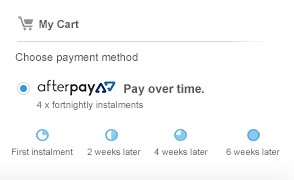Kawasaki KXF250 piston kit from Wossner have been developed for both the racer seeking and reliability, and the everyday trail rider.
Check Specs & Technical Info - About forged pistons - How to break a new piston or rings in - Installing instructions - What compression to octane fuel - Piston & ring problems
Wossner Kawasaki KXF250 piston kits include: Piston, Rings, Piston Pin & Circlips
- Standard Compression 13.5:1
- Wossner piston and rings can be used in all plated cylinders and cylinders fitted with a sleeve.
- Coated skirt aids bed-in, made to wear of within a few hours of use
- Note piston design can very than images as design for models change
- Image is generic and may differ slightly to part supplied.
(WOS8814DA)
Below is information on - Ring & Piston Installing - About Fuel & Compression-Octane - What Piston Compression to What Octane Fuel
Piston to Bore Clearance: Wossner pistons already have the recommended clearance built in. Skirt diameter is smaller than the recommended bore size (see sizing on box). Some applications: Nitrous, supercharged, turbo, and cold water marine engines may need more than the recommended clearance.
Pistons are measured 90 degrees from the piston pin axis of the piston skirt, with a micrometre and then a ball micrometre gauge used to check the piston to bore clearance.
Wossner clearances are set before coating. Coatings are 0.012mm thick and should be deducted when measuring for piston to bore clearance.
Adding additional clearance than recommended may create extra engine noise (piston slap) upon start up and cold running. This can cause damage to the piston and/or cylinder. Some piston noise is normal on engine start up and during cold running. This will reduce when engine is at operating temperature. It is advisable to avoid high loads or high RPM during engine warm-up.
Information about installing piston and rings
It is very highly advisable to check piston to bore clearance correctly before fitting a piston, this goes for all brand pistons including genuine.
If the piston has an arrow on the crown/top most of the time this will point to the front of the engine.
If the rings have a number, letter or dot on them, in most cases this mark will be fitted facing up, so it is visible when looking down from the crown/top of piston. (This normally only applies to the compression rings)
4-stroke only - Oil ring rails (the 2 piece set) in most cases can be fitted any way up.
Mainly 4-stroke – when fitting compression rings if more than one compression ring is supplied, in most cases the higher grade looking (most are a chrome colour) ring will be fitted in the top groove.
Ring Gap Instructions
1. This table is in inches. If you are measuring your bore in millimeters, you will need to convert to inches by dividing your bore size by 25.4
2. Multiply your inch bore size by the “Bore x” column for your application to determine the end gap.
Example: For the top ring of an bore with a 4.0” bore, multiply 4.0 X .004 = .016
Below 4 Stoke Ring Fitting Instructions


About Fuel and Compression
Compression – Octane
It is recommend with modern 4-strokes with 12:5 to 13.5: compression to use 95-96 octane fuel. With compression over 13.5 compression then 98 octane is recommended. You should not run your bike on lower than 95 octane even when stock.
Don't be a cheap skate
Engines are designed for a specific octane rating. If you use too low of an octane rating for your engine, the gasoline may combust before the spark ignites it. This isn't good for your engine, and you can actually ruin it by doing it. We hear people saying 'my bike runs better on 91 octane than 96'. Yes, it may perform the same and you may save a few short dollars in the short term but it will cost you more as the piston, crankshaft and bearing life will be shorter.
Does an engine run better on a brand?
It may be that you tell everyone, “my bike runs best on Caltex” and another one of your mates might say, “oh, but mine runs best on BP”. Not really. It all really depends on how fresh the fuel is. So if you go to a service station that has a high turnover, you have more of a chance of getting better fuel to look after your engine.
The actual effectiveness of current grade of fuels available can vary depending on how “fresh” they are. Standard unleaded can range from 91-93 octane, 95 premium can vary from 95-96 octane and the 98 premium can vary from 98-100 octane. E10 is 94 octane.
What is octane rating?
The octane rating of gasoline tells you how much the fuel can be compressed before it spontaneously ignites. When gas ignites by compression rather than because of the spark from the spark plug, it causes knocking in the engine. Knocking can damage an engine, so it is not something you want to have happening. Lower-octane gas (like "regular" 87-octane gasoline) can handle the least amount of compression before igniting.
The compression ratio of your engine determines the octane rating of the gas you must use in the engine. One way to increase the horsepower of an engine of a given displacement is to increase its compression ratio. So a "high-performance engine" has a higher compression ratio and requires higher-octane fuel. The advantage of a high compression ratio is that it gives your engine a higher horsepower rating for a given engine weight -- that is what makes the engine "high performance." The disadvantage is that the gasoline for your engine costs more.
What about ethanol in fuel?
All Honda, Kawasaki, Suzuki, KTM and Yamaha motorcycles are NOT suitable for E10 fuel. So beware of what pump you pick up. Many service stations have already changed over and are pretty well marked but still look carefully and ask the service station attendant if you’re unsure.
E10 fuel contains more oxygen than standard unleaded, which makes the air/fuel ratio leaner, therefore the oxygen sensor will compensate for this by richening the fuel mixture causing fuel consumption to go up by about 3 per cent.
Another bad thing with ethanol is that it absorbs water. If too much water is present, the ethanol and fuel can separate which is called “phase separation”. Pure ethanol on its own will cause damage to the fuel system, which is not a good thing. Ethanol can also damage fibreglass fuel tanks, so do not use E10 if you see it available.
Fuel Storage
Storage of fuel is one variable that can affect the performance of your bike. If the fuel is older than 4-8 weeks and hasn’t had any fresh petrol added, you may well experience reduced performance because the fuel loses volatility and octane rating. You will also experience difficulty starting because you will have lost some of the “light ends” of the fuel, which is what starts the engine. Possibly spark plug fouling will have occurred as well because the density of the fuel will have increased and probably will have caused flooding because of the richer air/fuel mixture.
You know when you open the fuel container for the mower and it makes that “psst” sound? That’s the fuel losing its “light end” properties, or volatility and it’s why the mower is so hard to start after the fuel has been around for a while.
Having seen on paper how the “psst” factor, condition and temperature can affect overall performance, we suggest that if you have to store fuel, keep it in as cool a place as possible in a well ventilated area and avoid opening the container as much as is possible.. If fuel is left unused for a long period it can turn into a gummy type liquid that blocks fuel lines and, depending on how bad it is, will result in your bike not starting and might even require that the fuel system be cleaned or replaced.
| SKU | WOS8814DA |
| Brand | Wossner |
Be The First To Review This Product!
Help other MotoXparts users shop smarter by writing reviews for products you have purchased.


























































































































